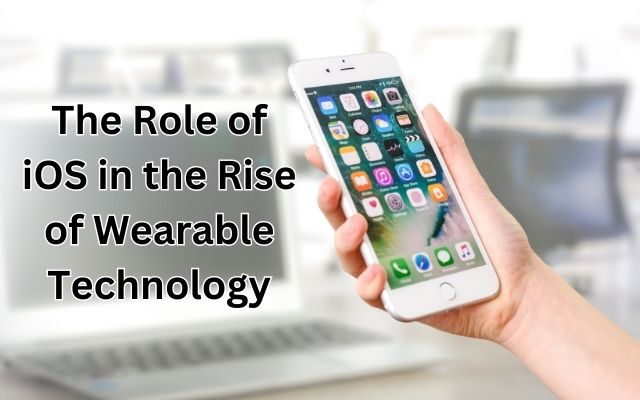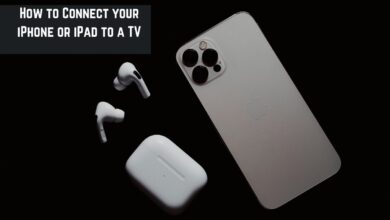The Role of iOS in the Rise of Wearable Technology

The role of iOS in the rise of wearable technology is a fascinating journey to explore. This journey begins with the advent of wearable devices, which were initially simple gadgets with limited functionality. However, the introduction of iOS into this domain marked a significant turning point.
Apple’s iOS, known for its user-friendly interface and seamless integration with other Apple devices, has played a pivotal role in transforming wearable devices from mere gadgets to powerful tools that are now an integral part of our daily lives. The iOS platform, with its robust and secure architecture, has enabled developers to create a wide range of applications for wearable devices, thereby expanding their capabilities beyond imagination.
From fitness trackers that monitor our health to smartwatches that keep us connected, iOS has been at the forefront, driving innovation and setting new standards in the wearable technology industry. The impact of iOS on wearable technology is profound and far-reaching, shaping not only how we interact with these devices but also how we perceive and use technology in our daily lives.
In this article, we will delve deeper into the role of iOS in the rise of wearable technology, exploring its evolution, current applications, and potential future trends. So, let’s embark on this exciting journey together, unraveling the transformative role of iOS in the ever-evolving world of wearable technology.
Evolution of Wearable Technology
The evolution of wearable technology has been a journey of innovation and advancement, with iOS playing a significant role in its progression. In the early stages, wearable devices were simple gadgets with limited functionality. However, the introduction of iOS into this domain marked a significant turning point.
Apple’s iOS, with its robust and secure architecture, has enabled developers to create a wide range of applications for wearable devices, thereby expanding their capabilities. The iOS platform has been instrumental in transforming wearable devices from mere gadgets to powerful tools that are now an integral part of our daily lives.
In 2022, we saw a bumper year of product launches, with Apple, Google, and Samsung all debuting new product lines of some description. High-profile product launches and health tech innovations marked the year, shaking off the last remnants of the pandemic hangover and getting back to business.
One of the key players in this evolution has been the Apple Watch, which has revolutionized the way we interact with technology. The Apple Watch, powered by iOS, offers a seamless user experience, with features such as fitness tracking, heart rate monitoring, and even ECG capabilities.
Another significant development has been the integration of iOS in health and fitness trackers. These devices, equipped with advanced sensors and powered by iOS, provide users with valuable insights into their health and wellness.
The evolution of iOS in wearable devices has not only transformed the way we use technology but also how we perceive it. Wearable technology, powered by iOS, has moved beyond being just a novelty to becoming a necessity in our daily lives.
As we look ahead, the role of iOS in the evolution of wearable technology is set to become even more significant. With advancements in technology and increasing consumer demand, the future of iOS in wearable technology looks promising.
iOS in Current Wearable Technology
The current landscape of wearable technology is diverse and dynamic, with iOS playing a central role in shaping its trajectory. From smartwatches to fitness trackers, iOS has been instrumental in enhancing the functionality and user experience of these devices.
One of the most notable examples of iOS in current wearable technology is the Apple Watch. This device, powered by iOS, offers a seamless user experience with features such as fitness tracking, heart rate monitoring, and even ECG capabilities. The Apple Watch exemplifies how iOS has transformed wearable devices into powerful tools that can monitor our health and keep us connected.
Another significant development is the integration of iOS in health and fitness trackers. These devices, equipped with advanced sensors and powered by iOS, provide users with valuable insights into their health and wellness. They can track various health metrics, such as heart rate, sleep patterns, and physical activity, thereby helping users maintain a healthy lifestyle.
Furthermore, iOS has also made significant strides in the realm of wearable GPS technology. Wearable devices powered by iOS can provide accurate location-based services, thereby enhancing the user experience. This feature is particularly useful in fitness trackers and smartwatches, where it can help users track their workouts and navigate their surroundings.
In addition to these applications, iOS is also paving the way for the integration of Artificial Intelligence (AI) in wearable technology. AI can provide personalized insights and recommendations based on the user’s health data, thereby taking the functionality of wearable devices to a whole new level.
Moreover, iOS is also focusing on enhancing data security in wearable devices. With the increasing amount of sensitive health data being collected by these devices, data security has become a paramount concern. iOS, with its robust security features, ensures that the user’s data is protected from potential threats.
Case Studies of iOS in Wearable Technology
In this section, we will delve deeper into the role of iOS in specific wearable devices. Two prominent examples that stand out are the Apple Watch and various health and fitness trackers.
Apple Watch and iOS
The Apple Watch is a prime example of iOS’s impact on wearable technology. This device, powered by iOS, offers a seamless user experience with features such as fitness tracking, heart rate monitoring, and even ECG capabilities. The Apple Watch exemplifies how iOS has transformed wearable devices into powerful tools that can monitor our health and keep us connected.
The Apple Watch’s success can be attributed to the robust and secure architecture of iOS, which has enabled developers to create a wide range of applications for the device. These applications have expanded the capabilities of the Apple Watch, making it more than just a timepiece.
iOS in Health and Fitness Trackers
Another significant development is the integration of iOS in health and fitness trackers. These devices, equipped with advanced sensors and powered by iOS, provide users with valuable insights into their health and wellness.
Health and fitness trackers powered by iOS can track various health metrics, such as heart rate, sleep patterns, and physical activity. This data can help users maintain a healthy lifestyle and even detect potential health issues at an early stage.
Moreover, iOS’s robust security features ensure that the sensitive health data collected by these devices is protected from potential threats. This focus on data security is a testament to iOS’s commitment to user privacy and data protection.
Future of iOS in Wearable Technology
As we look ahead, the role of iOS in the evolution of wearable technology is set to become even more significant. With advancements in technology and increasing consumer demand, the future of iOS in wearable technology looks promising.
One of the key trends that will define wearables in 2024 and beyond is the integration of Artificial Intelligence (AI) in wearable technology. AI can provide personalized insights and recommendations based on the user’s health data, thereby taking the functionality of wearable devices to a whole new level. For instance, the Black Shark S1 Pro, a smartwatch built for hardcore gamers, will launch soon with ChatGPT Voice support built-in, likely allowing users to accomplish an enormous range of tasks via voice.
Moreover, there is a growing focus on non-wrist-based wearables. The Oura Ring, one of the most popular smart rings on the market, is due for a refresh in 2024. We suspect the new device will have a thinner design, additional health-centric features, and possibly even support for digital payments.
In addition to these trends, iOS apps powered by IoT technology will continue to revolutionize how people track their health and fitness routines through their smartwatches and phones. This trend is expected to continue in 2023, with more iOS apps integrating with wearable technology, allowing users to access app features directly from their wrist.
However, the future of iOS in wearable technology also presents several challenges. One of the key challenges facing current wearable computing devices is the lack of killer apps. Without a variety of robust apps serving the different needs of consumers, the future of wearable devices will be cloudy at best.
Another challenge is power management. Wearable devices need to be lightweight and comfortable to wear, which limits the size of the battery that can be used. As a result, optimizing power consumption is a critical aspect of wearable device design.
Despite these challenges, the future of iOS in wearable technology looks bright. With its robust and secure architecture, iOS is well-positioned to drive the next wave of innovation in wearable technology.
Conclusion: Role of iOS in the Rise of Wearable Technology
The role of iOS in the rise of wearable technology has been transformative. From the early stages of wearable devices to the current landscape, iOS has played a pivotal role in shaping the trajectory of wearable technology.
The integration of iOS in devices like the Apple Watch and various health and fitness trackers has revolutionized the way we interact with technology. These devices, powered by iOS, have moved beyond being just gadgets to becoming powerful tools that are now an integral part of our daily lives.
Looking ahead, the future of iOS in wearable technology looks promising. With advancements in technology and increasing consumer demand, iOS is well-positioned to drive the next wave of innovation in wearable technology.
However, the journey is not without challenges. Issues such as the lack of killer apps and power management are critical aspects that need to be addressed for the continued growth of wearable technology. Despite these challenges, the robust and secure architecture of iOS gives it a strong foundation to overcome these hurdles.
Frequently Asked Questions
What is wearable technology?
Wearable technology refers to electronic devices that are designed to be worn or implanted in the body. These devices, such as smartwatches and fitness trackers, can perform many of the same computing tasks as mobile phones and laptop computers.
How has iOS influenced the rise of wearable technology?
iOS, with its robust and secure architecture, has played a pivotal role in the rise of wearable technology. It has enabled developers to create a wide range of applications for wearable devices, expanding their capabilities and transforming them from mere gadgets to powerful tools.
What are some examples of iOS in wearable technology?
The Apple Watch and various health and fitness trackers are prime examples of iOS in wearable technology. These devices, powered by iOS, offer a seamless user experience with features such as fitness tracking, heart rate monitoring, and even ECG capabilities.
What is the future of iOS in wearable technology?
The future of iOS in wearable technology looks promising. With advancements in technology and increasing consumer demand, iOS is well-positioned to drive the next wave of innovation in wearable technology. Key trends include the integration of Artificial Intelligence (AI) in wearable technology and a growing focus on non-wrist-based wearables.
What are the challenges facing iOS in wearable technology?
Despite its success, iOS faces challenges in wearable technology, including the lack of killer apps and issues with power management. However, the robust and secure architecture of iOS provides a strong foundation to overcome these hurdles.
How does iOS enhance the user experience in wearable technology?
iOS enhances the user experience in wearable technology with its user-friendly interface and seamless integration with other Apple devices. This makes it easy for users to interact with their wearable devices, and iOS’s robust security features ensure the protection of sensitive health data.
How does iOS contribute to the health and fitness aspect of wearable technology?
iOS plays a significant role in the health and fitness aspect of wearable technology. Health and fitness trackers powered by iOS can track various health metrics, providing users with valuable data to maintain a healthy lifestyle and detect potential health issues early on.
What role does iOS play in the data security of wearable devices?
iOS plays a crucial role in ensuring data security in wearable devices. With its robust security features, iOS protects sensitive health data from potential threats, enhancing user trust in wearable devices.
How is iOS paving the way for the integration of AI in wearable technology?
iOS is paving the way for the integration of AI in wearable technology by providing a platform for personalized insights and recommendations based on user health data. This takes the functionality of wearable devices to a new level.
What is the impact of iOS on the wearable technology industry?
The impact of iOS on the wearable technology industry is profound, transforming how we use and perceive technology. As the journey continues, the influence of iOS in the wearable technology landscape remains significant and continues to shape the industry.







